Let’s get down to business: When IS the best time to see northern lights in Iceland?
Finding out the best time to see northern lights in Iceland is one of the penultimate quests of every visitor. One of the biggest draws to visit, they are also one of the most difficult activities to plan. Although it would be great to easily pinpoint how and when (and where!) to see them, there are quite a few variables involved in a successful sighting.
Things like season, weather/cloud cover, length of stay/time spent hunting, solar activity, and a bit of luck. We’ll explore these factors a bit more through the article, but to give you the paraphrased rundown:
- Season: mid-August to early April
- Weather: Little to no cloud cover
- Length of stay: 5-7 days (On average, if the weather is cooperating and you are spending most evenings looking for auroras, you may have somewhere around 2.5-3 opportunities to see an aurora. This is of course conditional on if you are willing to move around and if you are here during stormy weather, but typically a week gives you a few chances to try for a sighting.)
- Solar Activity: This far north we can see fairly low activity, as we lay within the 3rd band of the kP chart. In theory, this means that activity needs to occur at a kP 3 level to be visible in Iceland, but due to the rapidly changing development of this forecasting system and the interpretation of data, it does happen often that lower levels of activity are visible here. We’ve gotten lucky on a 0 night before, and so can you! Natural phenomena do tend to be unpredictable, even after years of scientific study.)
Luckily, there are a lot of fantastic things to do in Iceland and it’s always best to think of seeing the northern lights as an added bonus. Depending on where in the season you visit, there are plenty of extra activities to plan your trip around.
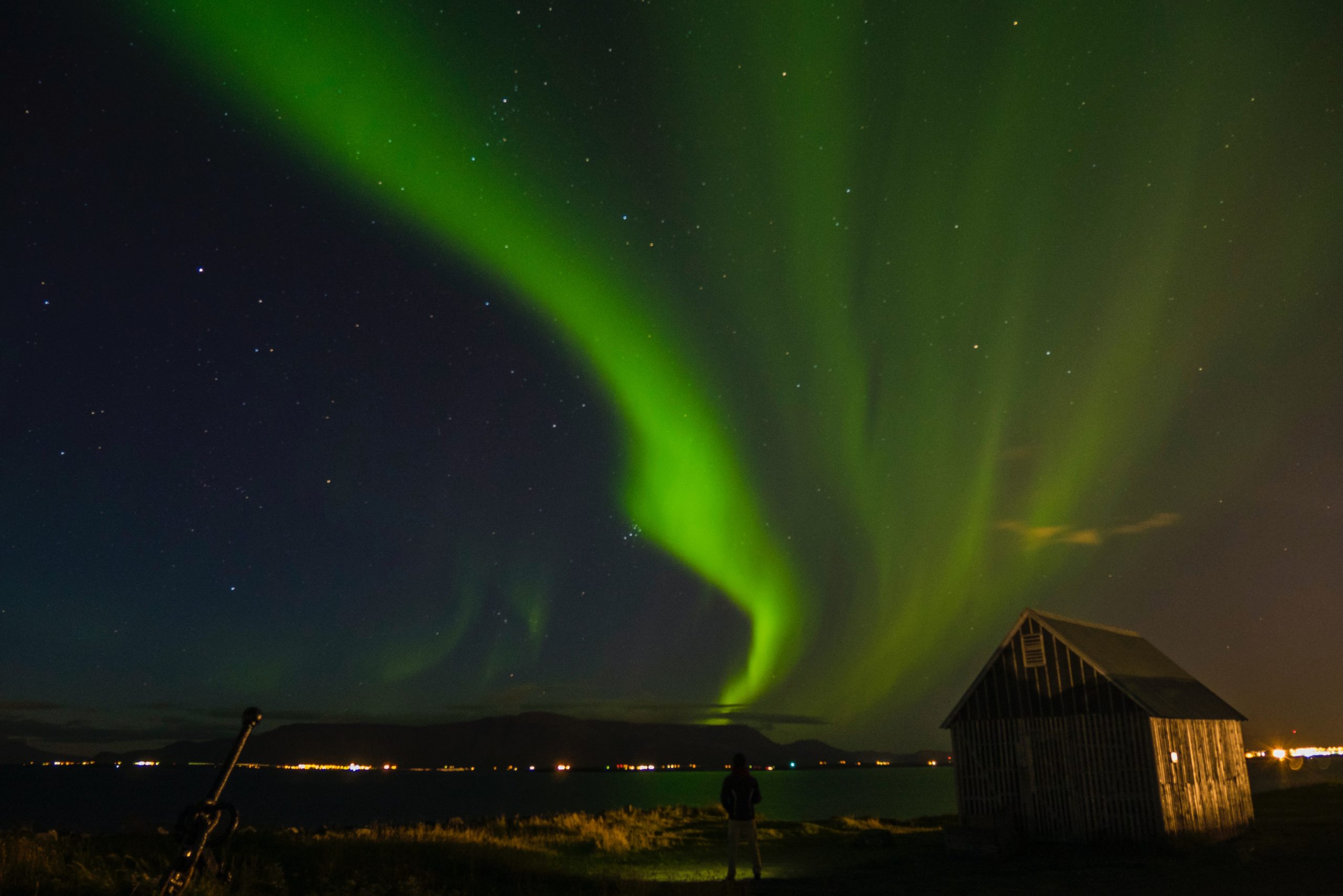
What Are The Northern Lights?
First, a little bit of background on the aurora. The northern lights are the result of electrically charged particles from the sun colliding with gaseous particles in the Earth’s atmosphere, causing displays of bright, colorful dancing lights.
They are visible in the magnetic polar regions of the northern and southern hemispheres (they are known as Aurora Australis in the south) and they can range in color from white, green, red, pink, and purple.
Depending on your own personal color processing, these colors can appear differently to you than to your neighbor, which is a curious thing to explore when viewing an aurora with a friend.
These colors are created by the collision of the particles with different gases, and so it is not impossible for rarities like yellow, orange, blues, and reds can occur. Due to color frequency, some of these are harder to see than others.
According to the Northern Lights Centre in Canada, scientific studies have found that the northern and southern Auroras often occur at the same time as mirror images.
This of course means that the Auroras are often happening, even if they aren’t visible to us down on the ground. There are theories that while these occurrences may be happening simultaneously, they may be more like siblings, than twins, in appearance.
The best time to see Northern Lights in Iceland can vary depending on conditions. But because of the length of our light cycle, the good news is that there’s a perfect piece of the auroral season for everyone.
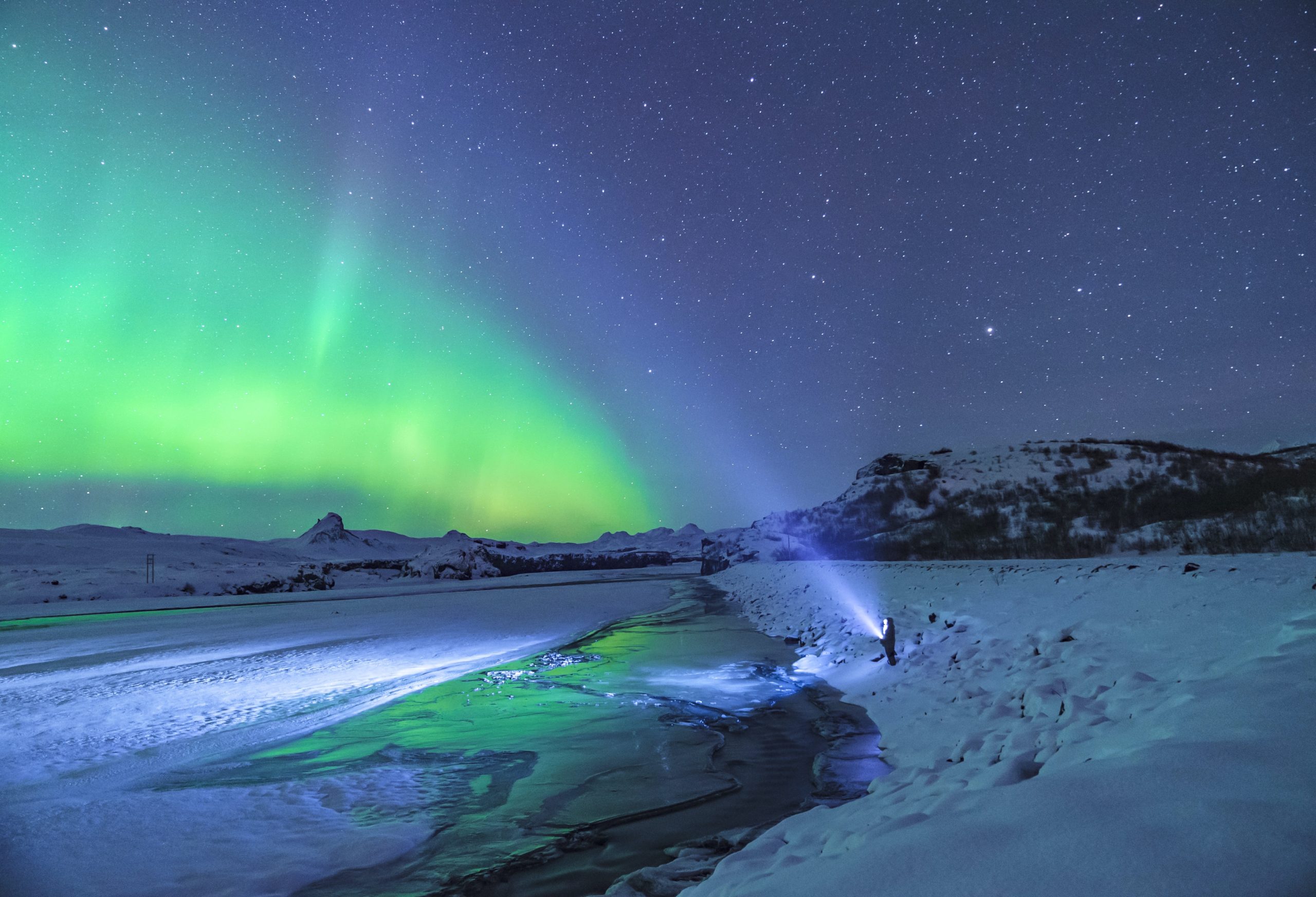
The difficulty here is that a great deal of this activity would only be visible primarily from Antarctica, which does not host a very large population. This means that the qualitative observation of the Aurora Australis is not quite as large as that of the Aurora Borealis, in the north. We are getting closer, though!
In the northern hemisphere, the lights are best seen from Iceland, Finland, Greenland, northern Norway and Sweden, Siberia, the Canadian territories, and Alaska. Thanks to the latitude of the North American continent in relation to the magnetic pole, the lights have been seen as far south as New Orleans!
This is a rare and remarkable thing and is the gift of large solar storms. Here in Iceland, seeing the northern lights is most certainly annual and regular, although still difficult at times to predict.
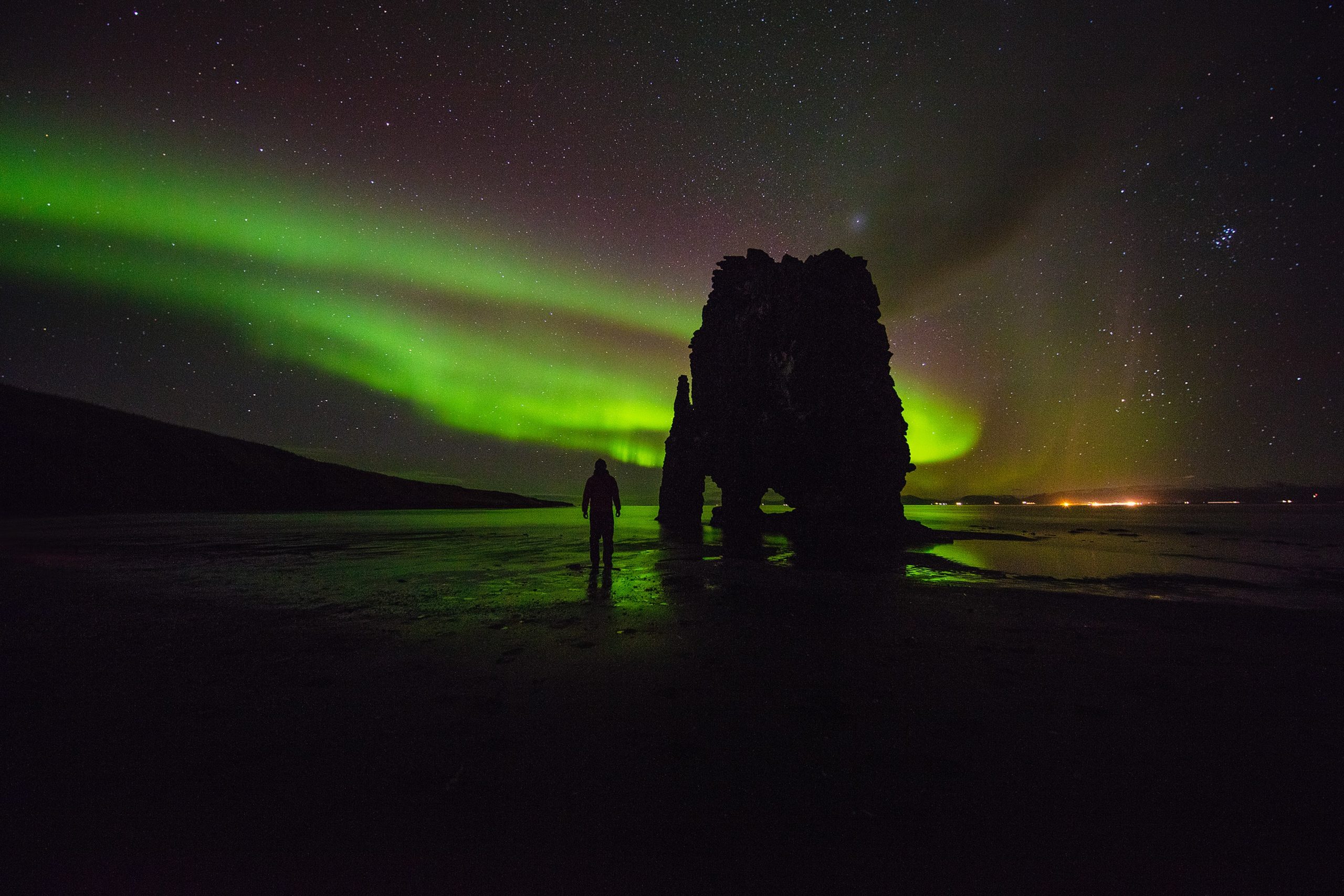
The Best Time To See The Northern Lights In Iceland
As mentioned early, to see the northern lights in Iceland, it is important first to be here in the correct season, which is mid-August to early April. (It is not impossible to see the lights in early August or mid-April, but typically it would be too bright before and after that timeframe.
It is always good to remember when dealing with a wonder of the natural world, that there are exceptions for every single thing. The aurora may have a season, but that season is only bound to our light cycle. Auroral activity can happen at ANY time, we just lack the proper darkness to view it outside of that time frame.)
And speaking of darkness, guaranteed darkness is the first most important factor. The best season to see the northern lights in Iceland with solid darkness is from September to March, as these are the months where there are full dark nights.
Some sources will recommend December to February, as they are the darkest months with the longest possible window to see the lights, however, these sources often fail to take into account that these months can have the most volatile weather.
This can be a stormy time of year, which often complicates domestic travel and creates a great deal of cloud cover. This is why many aurora hunters prefer Spring (March) and Autumn (mid-August to November), as it is a milder time of year.
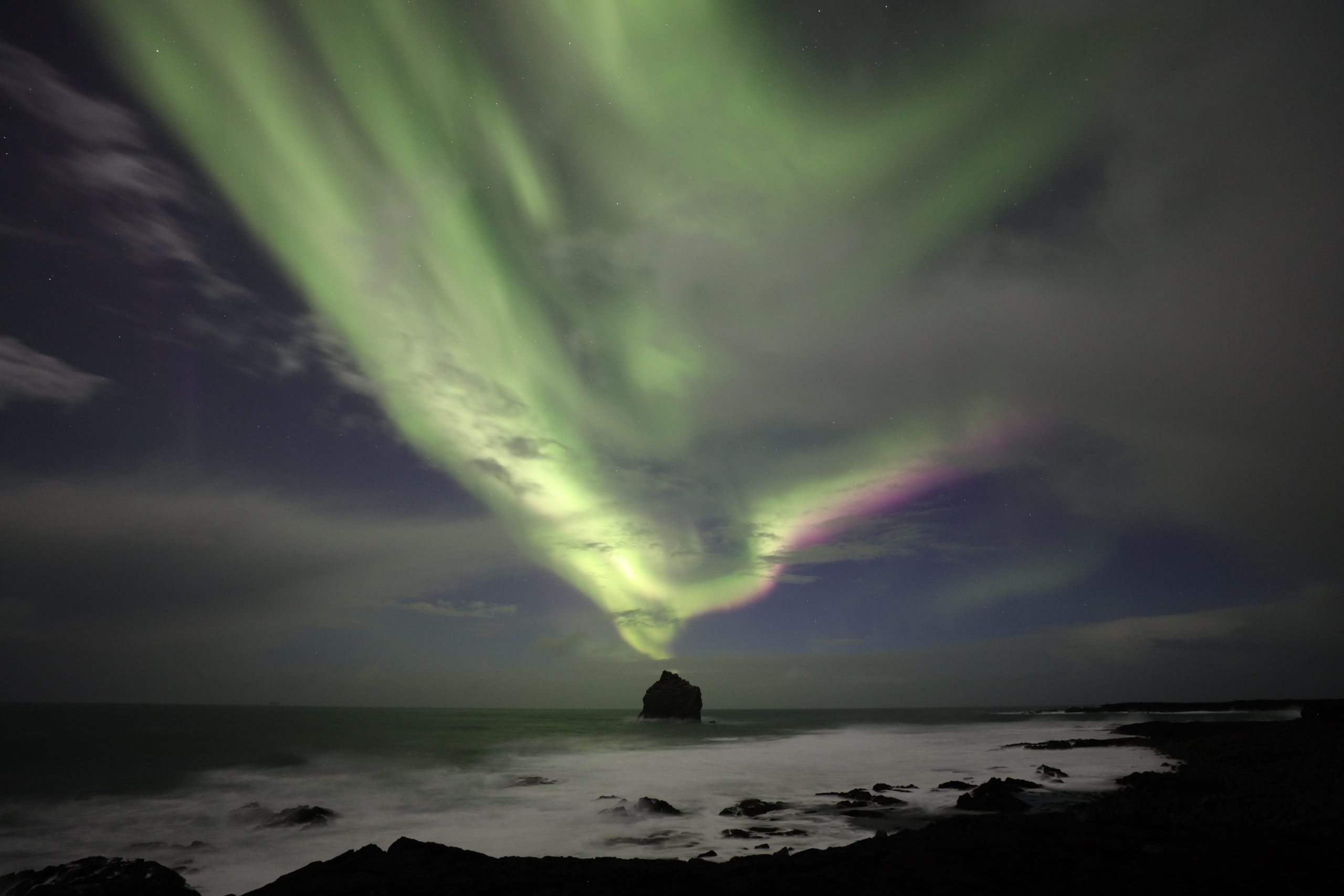
The length of time you choose to stay in Iceland is also an important factor. To increase your odds of seeing the lights, it is recommended you stay a minimum of seven nights in the country. The northern lights usually tend to be very active for two to three nights, then low for four to five nights, in ongoing cycles.
Naturally, not everyone can take long trips and Iceland is a renowned stopover destination, but if the northern lights are on your bucket list, it helps to have a few extra nights to explore.
(It’s also clever to start looking early in your trip, as opposed to saving your aurora excursions for a grand finale! Many tours allow a re-try if you have a less than fruitful night, so it is wise to give yourself some time to try again.)
Given that the factors for viewing the aurora have to all be aligned, the longer time you spend in the country, the higher your chances are of seeing them.
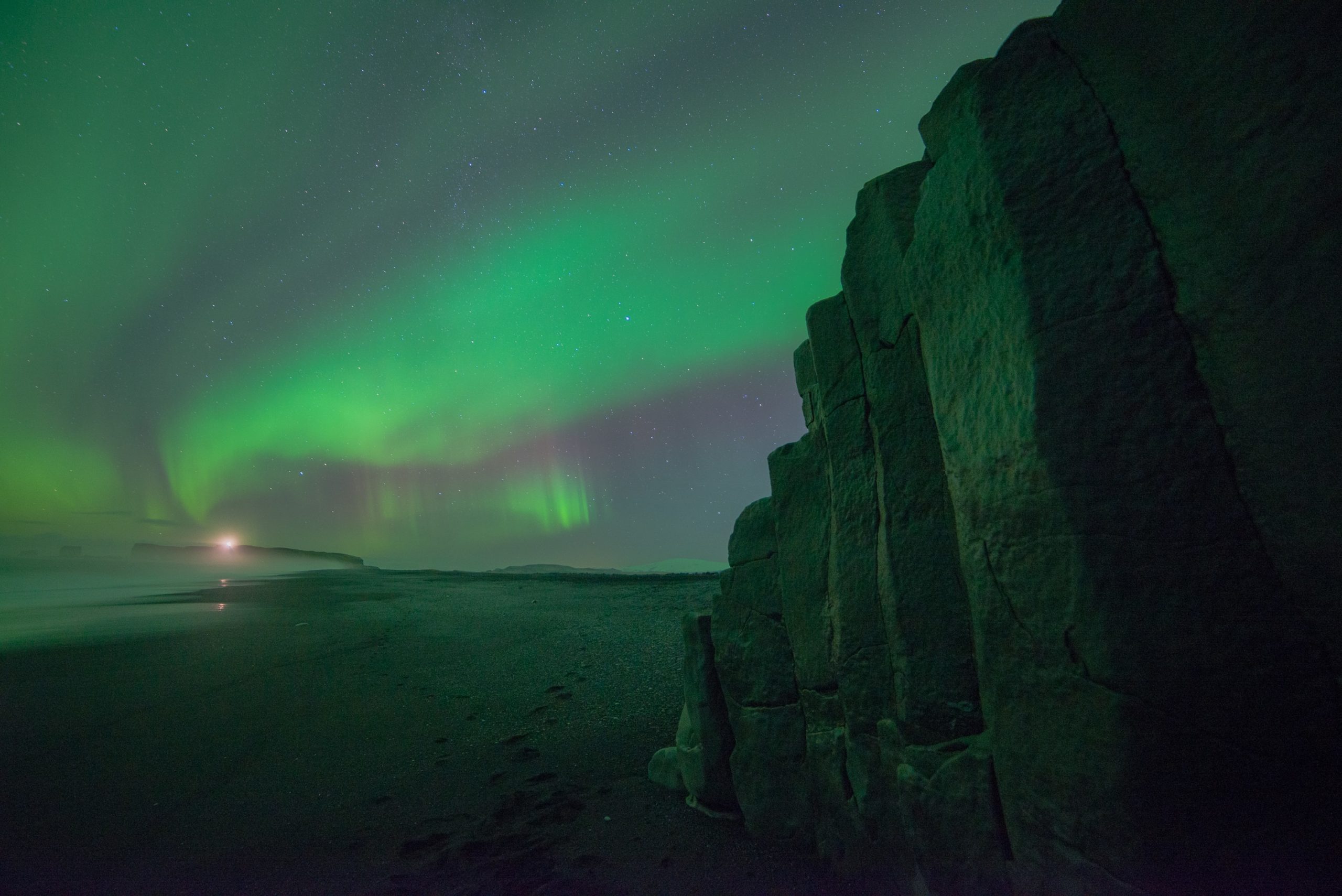
The weather is another important factor, but not necessarily for the reason that you may think. Since Iceland is a small north Atlantic island, it is subject to fierce and rapidly changing weather. The old cliché “if you don’t like the weather, wait five minutes” could not be truer of this country.
In order to see the northern lights, the skies need to be very clear. This often coincides with some of our coldest nights, since clear dark weather in Iceland usually means temperatures near or below freezing.
On warmer nights, there is usually precipitation or at least quite a bit of cloud coverage. Many people connect the northern lights with cold temperatures, but this is not required for their visibility.
The aurora happens above our weather system, so these things are only tangentially related. As long as the skies are clear, we can see the show.
Checking the different forecasts in the days leading to your trip to Iceland will give you an idea of your chances of seeing the lights.
Services like the aurora forecast from the Icelandic Meteorological Office are very useful. When you use this forecast, you are looking for the white spaces on the forecast map, instead of the green or colored areas on the map.
These white areas indicate the clarity of the sky, as opposed to layers of cloud cover which are denoted by a color spectrum. You can also see the predicted amount of solar activity on a 0-9 kP scale.
This scale is not always 100% accurate, so it is important to use it as a guideline, instead of an imperative. If you can see the sky in your area, it is worth having a look.
This is of course one of many tools, and these forecasts can all help to lend a bigger picture of what is truly a global event.
When we watch the aurora from one area, we are only seeing a small shard of a planetary occurrence, and so you can imagine how hard it is for a forecast to pinpoint the visibility of such a large thing in such a small area.

As the old saying goes, location location location! People are always looking for the best spot to watch from, and due to cloud cover and the unpredictable movement of auroral activity, the truth is that there is no singular good spot. However, you can make sure that your spot is less affected by the little gifts of mankind.
Once in a while, the northern lights will take Reykjavík by surprise and they are so strong that the city lights don’t matter, but most of the time, it’s best to get away from all the street lights and car headlights.
Taking your visit out of the capital and into the countryside further increases your chances of catching a show, and makes the whole experience a bit more magical.
There are many great small towns to visit around the country with beautiful country hotels and guesthouses, just steps from pure un-modernized nature where there is no light pollution. Fortunately, Iceland is a small place, so it doesn’t take much time to get out of the city light, and into some true darkness.
One of our favorite northern lights hotels in Iceland is the Bubble hotel, on the Golden Circle and the South Coast. We love the Bubbles for their convenient location near popular landmarks,
but also because it gets so incredibly dark there. In one of the comments on Tripadvisor, a client wrote: “I just walked outside of the hotel, just [a] few meters and it was simply pitch dark. So pitch dark I could not find myself.”
To be in complete darkness in the embrace of nature is amazing in itself, but it certainly is a great spot for aurora watching. (And a warm one, as well! Can’t miss the show if you’re in a transparent house!)
When choosing a trajectory to explore, you’ll want to make sure that you have chosen a direction based on cloud cover for that night. Many guides plan their excursions this way and choose their route because of these areas of clarity.
There are quite a few gorgeous towns just off of Route 1 within three hours of Reykjavik that you can head off in the direction of. For aurora hunters headed north/northeast, we can suggest the national park Thingvellir, Borgarnes, Akranes, and even Stykkishólmur.
You can also venture back out towards Keflavík and enjoy the vastness of the Reykjanes peninsula, or head south to the black sand beaches of Vík, the cozy town of Selfoss, of the coastal villages of Eyrarbakki or Thorlákshöfn. No matter where the skies are clear, there will be quite a few stops you can make.
Always take care to make sure that you are pulling over in spaces that are designated stopping points, and not stopping in the middle of the road or in a place where traffic may not expect you. Many accidents occur this way and are not the ideal experience for any hopeful aurora hunter.
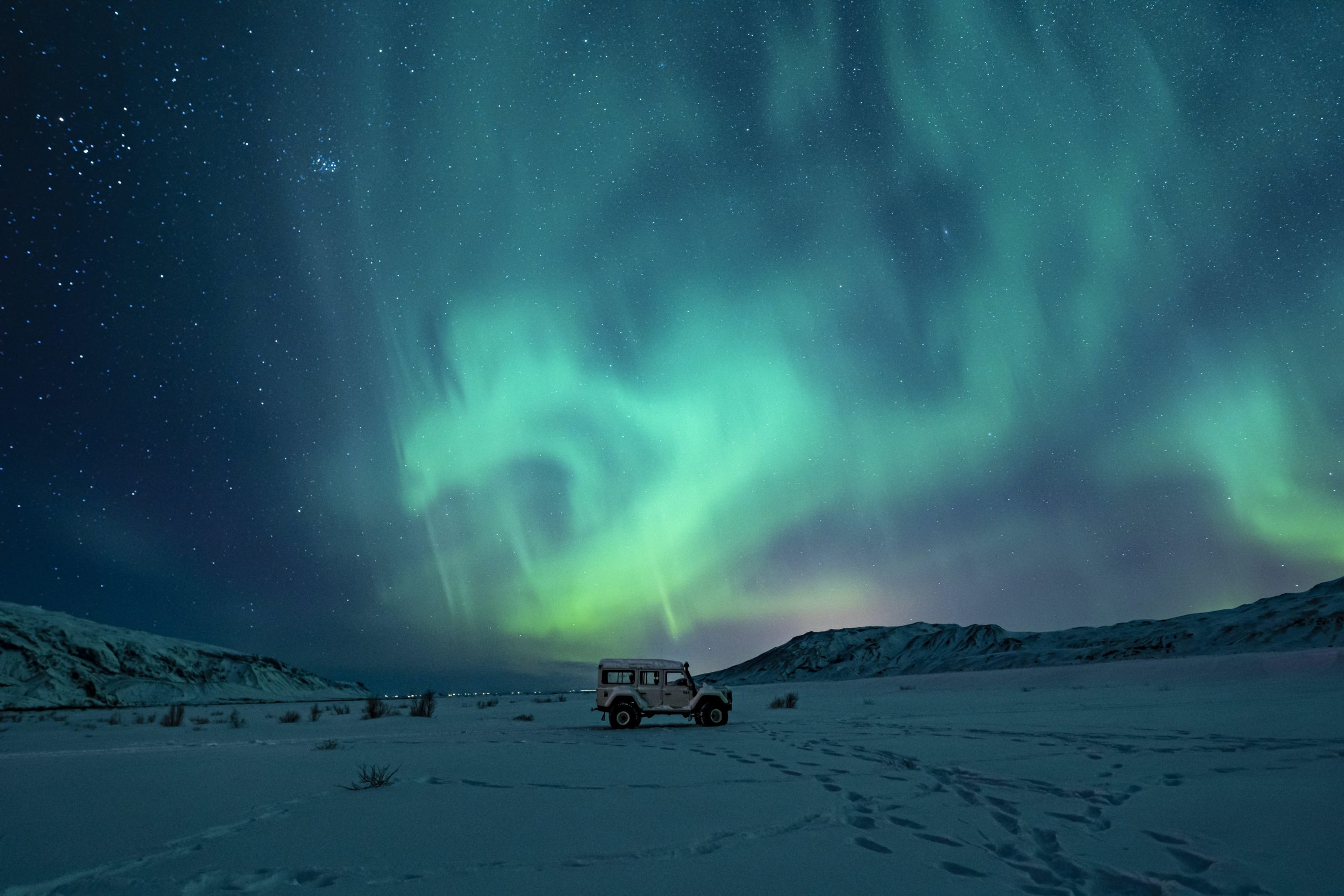
Guided Tours vs. Self-Driving: The Showdown
One big question that many people have is whether to go on guided tours or to self-drive around to find the lights. Both of these options have their pros and cons and some people end up doing a combination of both, which can be a cool way to inform your own process.
Guided tours have the advantage of being led by experts and drivers who closely follow the forecasts and have a keen knowledge of the road conditions and terrain. These are people that go out most nights and have quite a bit of experience under their belts.
Depending on the type of tour that you book, they may even have knowledge of the stars, nighttime photography, or the folklore of the northern lights in this area.
(This can also be a really nice experience if you don’t want to do any driving or route mapping. They take care of it for you, and they have to decide the route differently every night!)
Of course, guided tours can be subject to change based on unpredictable conditions, and do cancel if they feel the conditions are not optimal. This can be a challenge for a very tightly planned trip, so try to book your excursions earlier in your vacation to leave time for re-scheduling.
A self-drive can also be a good option, but only if the driver is very familiar with winter roads. Icelandic roads can be very icy as soon as September hits, so it’s important for drivers to be experienced and comfortable in all weather conditions.
It is also very important to follow road regulations and safety precautions given by your rental company and the Icelandic Association for Search and Rescue. Provided you are comfortable with this, building your own driving itinerary to go hunt down the lights can be a very rewarding adventure.
You will have a lot more freedom to hit the road on a whim if you see that the weather conditions are good near you and take on all the activities and sightseeing you want at your own leisure.
Of course, you have to be willing to do a lot more research on your own and be diligent to watch the skies closely, but you can stop to get snacks or go to the bathroom whenever you want! (Not to mention, if you want to stay out until 3 AM, you can! The guided tours typically last around 3 hours on average, so you do command a bit more freedom on a self-drive.)
If you plan to spend a considerable length of time here, combining both guided tours and self-driving can be a really excellent option.
You can stick to the easier routes on your own as you self-drive and have the same freedom to explore at your pace, but you can also treat yourself to a fun-filled adventure led by an expert guide. There are many tours that go to absolutely stunning locations to hunt for the lights, like the Jökulsárlón glacial lagoon or snowmobiling.
One other important thing to consider when coming to see the lights is bringing the appropriate attire. Remember: it will be winter! The key to dressing warmly in Iceland is lots of layers of natural fiber clothing – long underwear, cotton and wool socks, form-fitting shirts, and pants, topped off with insulated wind-and-waterproof outerwear.
If you plan on spending any amount of time outdoors, this will be crucial for keeping you heated inside and out. And don’t forget a good hat, scarf, and pair of gloves! If you forget anything though, don’t worry. Reykjavík’s main shopping street Laugavegur has many great stores where you can buy locally designed outerwear.

After the lights: other things to do in Iceland
At the end of the day, it’s really crucial to plan your trip around other activities and sights besides the northern lights. There are so many wonderful things to do in Iceland, and with the auroras being as fickle as they are, it would be a shame to not make the most of your visit.
There are all kinds of day trips accessible from the capital area, like the South Coast and Golden Circle routes. Easily done by guided tour or self-drive at all times of the year, these areas hold some of the country’s most notable landmarks.
On the Golden Circle route, you’ll see the Gullfoss waterfall, the original and eponymous Geysir, and the continental rift at Þingvellir national park, the first site of Iceland’s parliament.
Another favorite is the South Coast drive, home to the Seljalandsfoss and Skógarfoss waterfalls, the Reynisfjara black sand beach with its basalt column wall, and the beautiful seaside town of Vík. This little town rests sleepily under the volcano Katla, and if you visit in the summer, you may see the visiting Puffins!
For a longer drive along the south coast, continue on to see the Jökulsárlón glacial lagoon, where icebergs that break off of the great Vatnajökull glacier and float into the sea, before resting for a moment on the Diamond Beach. Each region of Iceland is home to otherworldly natural wonders, so make sure to see what you can while there’s light!
There is also a lot to see and do in the capital city of Reykjavík. Make sure to visit the Reykjavík Art Museum, a network of three separate centers housing a vast array of styles and eras of classic and modern art, each one dedicated to a famous Icelandic artist.
The National Museum of Iceland displays a fantastic permanent collection that beautifully transports you through the history of the country from the time of settlement until the present day. It also holds many temporary exhibits ranging from textile art to archeological reconstructions.
You can also indulge yourself with local cuisine, going to any number of marvelous restaurants specializing in some of Iceland’s best produce – lamb, lobster, and fish.
Then there is, of course, the city’s famous nightlife and bar scene that is not to be missed on weekends. The city goes from a quiet seaside town to an all-out rager on Friday and Saturday nights, and there are dozens of bars in the downtown area to suit every taste and fancy. Take in a bit of everything and you are sure to have a fabulous stay in this country, northern lights or not.
So now you’re ready to plan a trip! Remember the big factors: season, weather/cloud cover, length of stay/time spent hunting, and solar activity. (And of course the smaller details, like having the right gear, planning yourself some extra fun, and getting out of all that light pollution.)
With all these taken into account, hopefully, you will look up and be dazzled by the beautiful dancing lights. And if they don’t show themselves, you will still have had a great adventure in Iceland.
65 Comments
Add comment Cancel reply
You must be logged in to post a comment.

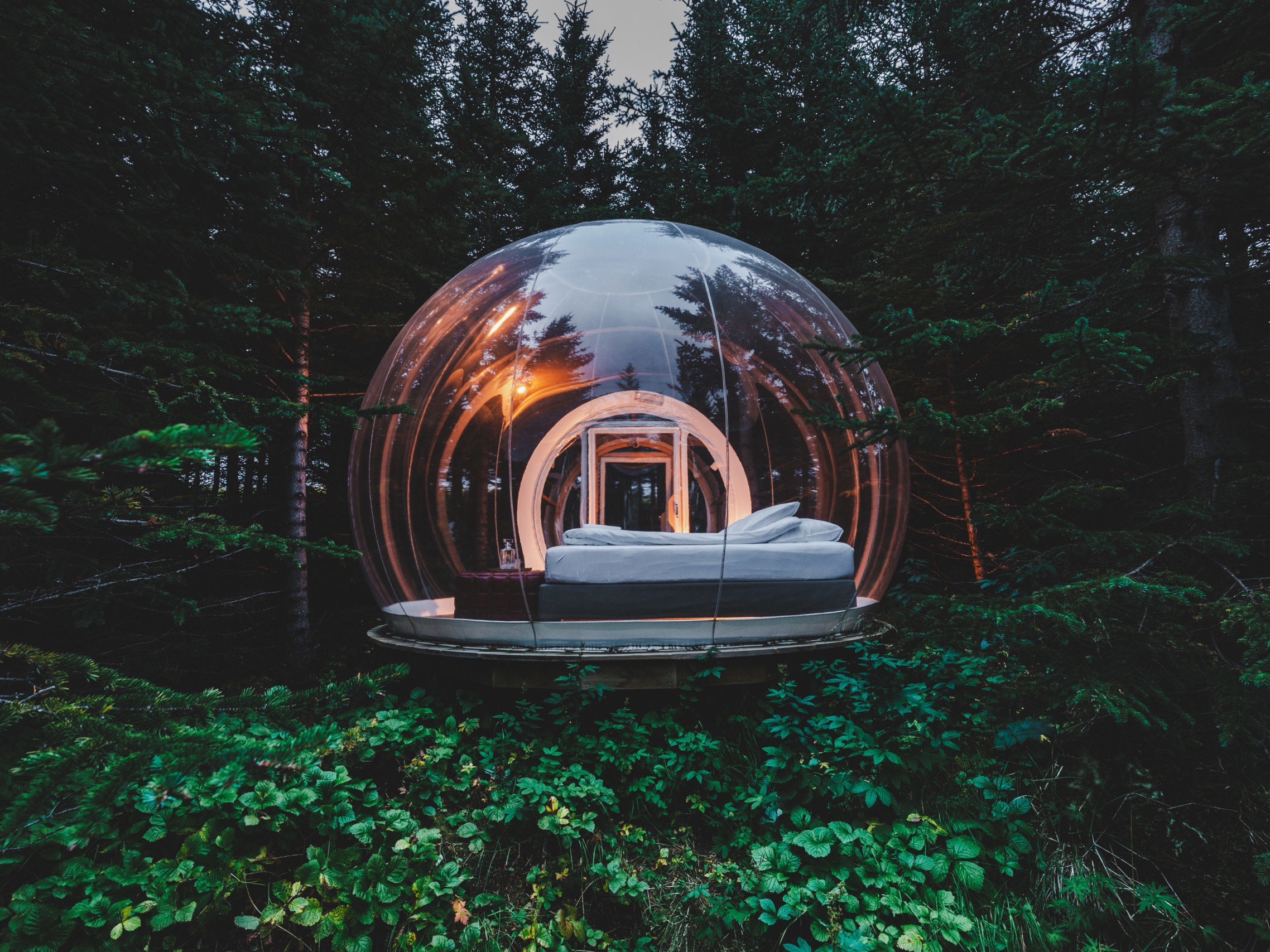
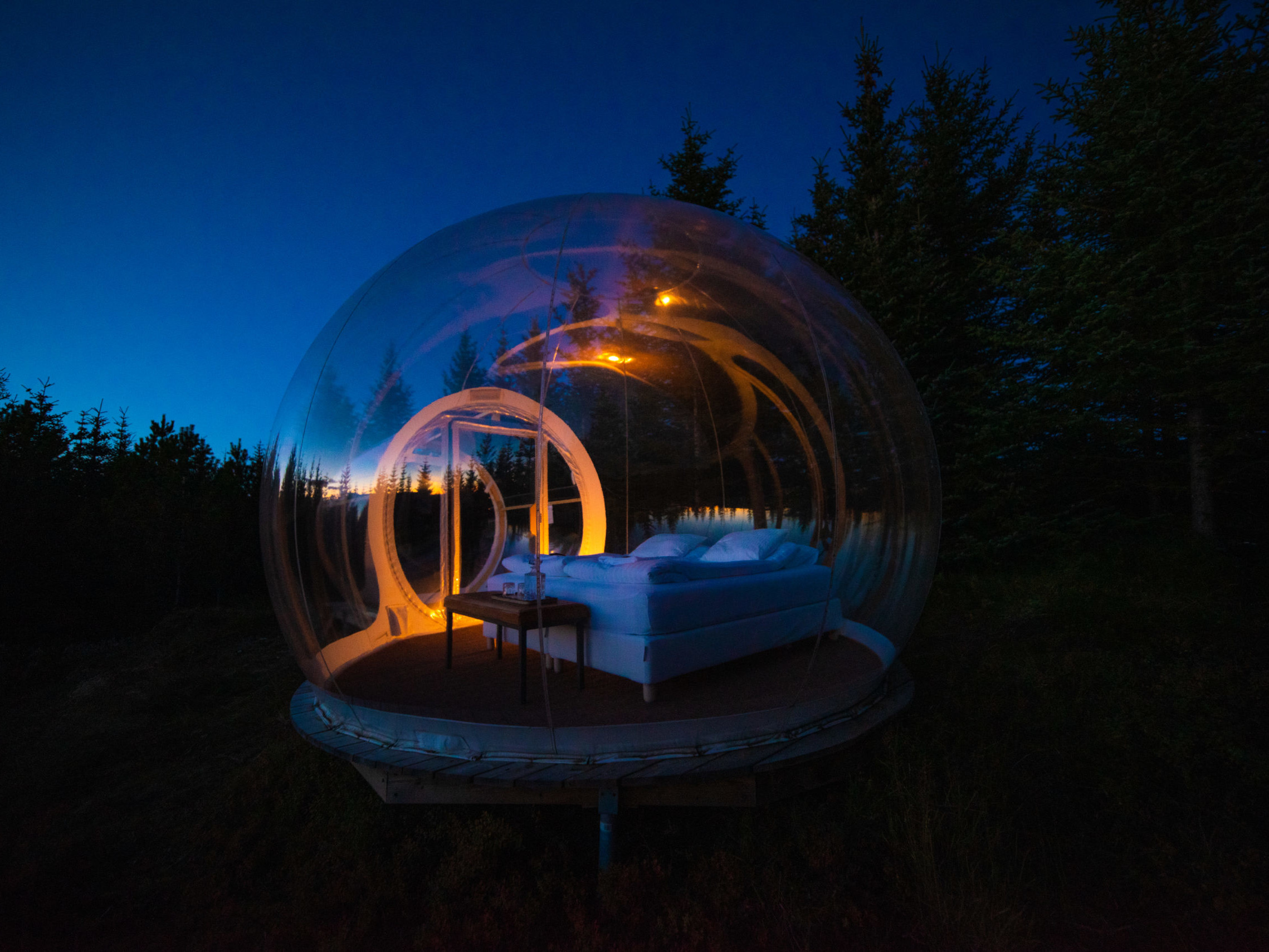
Thank you! I’m a night sky photographer planning a trip to Iceland.. this had some helpful information. See my work on my website (I make night sky films) at http://starmountainmedia.com
Woow some amazing footage you have shot! To say the least. You can send us a line at ferdamenn3@gmail.com if you need some help with the planning part
My husband and I leave for Rykjavik next week and see from the rainy forecast we probably won’t be seeing the elusive Aurora Borealis. Thank you for posting an Iceland vimeo so we can see what we’ll be missing and the beauty of Iceland that we WILL be experiencing!
I think I lost my comment. How can I find it? I’m new to this. 🙁
Can anyone tell me how likely I am to see the Northern Lights between 8-11 Dec 2014? Does it occur most nights if the sky is clear?
It is more and less impossible to give you any accurate chances. You might get some estimates 2-3 days before. And no it does not occur most nights if the sky is clear. We might have the solar storm creating aurora for 2-3 days and then nothing for next 6-7 days. So what all this comes down to if you want to increase your chances is to increase the number of days you stay in Iceland. That is the single most important advise. Also dont plan a trip to Iceland only to see the northern lights. Plan the trip to see Iceland as such and only look at it as a nice bonus if you see the lights. Look at tours like this one https://www.northernlightsiceland.com/aurora-floating-at-the-secret-lagoon/ because you will always get great experience even if you dont see the aurora.
Hi. Thank you for a great response. I more or less thought that was the case but I am was still a little unsure about the regularity of it. I want this trip to be perfect as it will be a surprise gift for my husband’s 50th birthday. I agree that the trip should not be just for the Northern Lights but it would be wonderful to see it 🙂 I will be staying in Reykjavik from 8-12 Dec so only 4 nights. I will also do the Golden Circle Tour to see the springs and falls and the Blue Lagoon Experience. I am wondering whether to also include the Game of Thrones Tour as my husband is a fan. Any other tips? Travelling from London with a tour operator if that helps. Thanking you in advance.
Did you make it to Reykjavik in December? How was it? what do you recommend doing/not doing? I would like to plan a trip for this coming December 2015
Yes I did. It was a fantastic holiday as it snowed heavily which created the magic I wanted. We did a 5 day trip. We arrived on Monday 8 Dec 14 in the afternoon so we walked down to Rejkavik town centre and had dinner. Tuesday to Thursday we did the excursions which were all wonderful. I recommend the Game of Thrones tour even if you don’t watch the series as I hadn’t. It was my husband’s surprise gift and he’s a GoT fan. The Golden Circle Tour which includes the Blue Lagoon and Northern Lights hunt is another must. The only negative was that on the night we spotted the lights, there were well over 15 coaches chasing all the spots at the same time so it was not the experience I wanted as too many people were around. It was cold as we were in the open but it was a phenomenon nonetheless. Tip: your fingers will freeze when take photos so take them fast. Unless you take your photos in gloves. I’m thinking of a girls Blue Lagoon trip for my birthday in Jan 15, that’s how great it was.
Hi,
Which Game of Thrones tour did you do and did it have a lot of overlap with the Golden Circle Tour? I’m heading over at the beginning of November and am trying to figure out what to do.
I’ll be planning a trip Sept./Oct…2015…and I hope to see the ‘lights, ride the ponies, swim in the pools’…and then on to London,Paris…just fun, fun…before we are entirely enslaved by the Elite..in the Agenda 21, Report from Iron Mtn…etc..They have created the bogus climate change, the chemtrails, the fraud, the theft, the in home energy audit, NO MORE CONSENT of any of this…see ‘Stop the Crime’ and you will see this is very real and coming to your city, town…
Hi there. First of all, thanks for all the tips. Really nice article.
But could u help me a bit more?
Well, i’m from Brazil and i’m planning to spent 6 days (5 nights) on Iceland during a Vacation on United Kingdom.
I not this time is not ideal to watch the Northern Lights, but as u said, i will to try to enjoy the country as a whole, not only the Aurora Boreal.
I will probably spend 2 nights at Reykjavik, 1 at Skaftafell, 1 at Vík and 1 at Hellar.
I will mix guided tours with self-driving.
What are my % chances to see the Northern Lights? 50%? Maybe more?
Thanks in advance.
Thanks for the info
Thinking of visiting Iceland somewhere around the first two weeks of September for five days. What possibilty do I have at seeing them? Should I postpone until October? What is off the beaten path? Two days in Reykjavik, and something local.
I’m planning to go on a trip to Iceland 30th of Aug. to 24th of Sep.. I really want to see the lights. Would you tell me how much possible for me to see them in September this year? And during the time which side of the country or which town is the best to see them? will it be better to join a tour if I’ll go by myself?
this article doesn’t even answer what the headline is….
Yes it does it’s very informative did u even read it ??
Thinking of booking for next September through icelandair, has any one had experience with them
Planning to visit in February 2016. My husband has a stamina problem which means he cannot walk too far and easily tires. Thinking of taking an organised package with Iceland Pro travel does anyone have any experience of this or suggestions which would help. Thank You
Hi its my hubby’s special brithday in November we are visitng from 27th to 30th, we are hoping to see the lights, keeping everything crossed. Whats the chances?
I would say you are chances are moderate. November is a good month however you are only staying for 3 days and that lowers your chance. Normally we recommend nothing less than one week. The lights might dance for us for 2-3 days and then nothing for 8-9 days, so you see why the number of days important
Oh I have installed the Auror app but have no idea how to read it, cant ask my hubby because its a surprise trip.
There are a lot of different apps, but one thing I noticed with the most of them is exactly the problem you are having, that you don’t really know how to use it. An app I’ve been working on solves this by presenting a simple, yet powerful tool, which present the current probability for auroral activity at a specific location. In other words, it will say the chance you have to see nothern light where you are, if weather conditions are good and it is really dark. Most likely to be launched in less than a week. You find it here, only for iOS though: http://www.viktornilsson.com/apps/auroranow/
Hi Viktor, do I take it correctly that you need to have Internet access whilst in Iceland for your app to work? Thanks
Hi Lilly and thanks for the reply! That is correct, the app needs some kind of internet access to work. Best regards, Viktor
Thank you for replying, we have 3 nights so will need to just hope and hope and hope. ?
am currently planning spending a week in Iceland from 10 – 17 Dec! Hoping to see the lights ..and all the other spectacular scenery the country has to offer! Am doing the fly-drive as am a photographer and want to be more flexible. Fingers crossed for the right conditions! 🙂
Sounds like a great plan. Flexibility is important but be careful in December / Jan / Feb / March. We might have serious snowstorms etc. Rent a 4×4 to be on the safe site and always have heavy duty winter clothes in the car in case something goes wrong e.g. get stuck on Holtavörðuheiði because of small cars (that is the most likely problem as there are always people that are careless). It happen to me once and the snowstorm killed the engine in 1 hour or so. So no heat in the car and nothing. Just pitch dark, crazy weather (you might if you are lucky see the red light on next car) and the only thing you can do is to wait for the rescue team to arrive.
Hi
Thanks for the reply! Yes, am hiring a 4×4 and have a lot of experience driving in severe conditions. Will be bringing an extra large case for all my winter gear!! Hoping to see some wildlife too ..if anything around in December! The island is deceptively large, and am looking to cram as much in as possible. I think there could be a lot of snowscapes being taken!
so good.
I’m considering a 5 day trip to Iceland, M-F, in January or February 2016 with “Great Value Vacations”. It includes hotels and breakfasts in Reykajavik, a tour of the Golden Circle and a search for the Northern lights. I’d also like to go to the Blue Lagoon…how could I accomodate that when it’s not a part of the tour? Any other must sees for a 5-day trip? Any experience, thoughts or considerations are welcome!
Same here, Paula. Please let me know what you find out. Thanks!
Hi there, I am looking at arriving 27 Feb & leaving 3 March. This should be enough time yeah? Or will it be too late to see the lights? I read that they said you should stay for a week but its tough to get that much time off. I am a little turned off with reading that there were lots of people there so I am leaning towards self drive and will get my partner to drive as he knows how to drive in snowy conditions. Would it however be a good idea to try a tour for one night? just to see what they have to say so if we miss it we can do it on our own and find our own way around?
Hi I’m going with my husband just for 3 nights next week for our anniversary , Sunday 24th Jan-Wed 27th Jan – at the moment it’s looking very cloudy and lots of rain and snow in the forecast – But I really want to see the lights so I’ll be praying alot!! Your website is very helpful. Just wondering, is the snow piled up in Reykjavic at the moment – trying to decide on the best footwear.
At the moment we have some snow piled up so expect a lot of snow, however when you are here in a week or so things might have changed completely. This is the reality of Icelandic weather and the risk when travelling here – it changes so fast. You need to be able to plan for all conditions. But I would say most likely you will have a lot of snow so plan accordingly.
ok thank you! By your experience – do you think we have a chance to see the lights – or is it really hard to tell?
It is really hard to tell. Normally people should plan for at least 1 week to increase the chances so 3 days is the main risk.
Hi coming to Iceland to see the Northern lights in 2018, when should we come? best time to see them? Thanks for helping.
so i can see u have visited from 24th to 27th jan, so how was your experience..? please help to share your experiences as we are planning to go in November 2016.
Hi Pranav,
Although we didn’t see the lights there are lots of lovely natural things to see in Iceland so if you like nature then it’s a beautiful place to visit – I recommend the Golden Circle tour and the South Shore tour – and there are also activities you can do there if you want to spend a bit of money 🙂
Do not expect to see the lights- take it as a bonus if you do – and even if you do – from the people I spoke to there, they said the lights are very faint – nothing like it appears in pictures!
Lovely people and a good experience in all.
I’m very glad I went.
I think your advise is spot on Zainab. Best to plan the trip as visiting Iceland as such and the northern lights if they dance are only a nice bonus. Often the lights are faint as you see but in between we also have lights to the bear eyes as you see them on pictures.
Hello, how many people do you take in each tour? My boyfriend and I are going to Iceland and Finland the second and third week of august. It seems we need a lot of luck to get to see them, but we will be hopeful and cross fingers. Is it possible to get in the tour if we trying booking 2 or 3 days before? we are not sure which exact days we will be in Iceland. Thanks!!
Great advice! Will be helpful when planning the Iceland ring road trip which we’ll document on our blog
Hello, I am trying to decide when to come, possibly when there is a better chance of seeing the Northern Lights, but when the days aren’t too short or too much extreme weather to see and enjoy all the natural beauty of Iceland, when would you suggest?
what are the chances to see the northern lights early January?
Been reading different things and not super sure
Do you recommend a particular jeep tour company(ies)?
I was thinking of buying a Groupon from Boston to see Iceland: Boston (BOS): Stay at CenterHotel Plaza, depart on 1/22/17 $699
Has anyone stayed at CenterHotel Plaza? Can anyone tell me how likely I am to see the Northern Lights between 1/22/17 – 1/28/17?
I’m planning my 40th birthday in Iceland, but it’s the first week in April 2016. Obviously, I’d love to see the Northern Lights while we’re there, but is this timing too late? Would it be better to go earlier…towards the middle or end of March?
Hi Jocelyn, you’ll have read from previous comments that seeing the lights is NEVER guaranteed whatever time you go. I’m not expert but from what I’ve read the lights can usually be seen up until mid-April, so keep your fingers crossed and try not to it ruin your holiday if you don’t see them. I’m heading there the first week of March in hope of seeing orcas and the lights, so I’ve got two reasons to keep my fingers crossed! Hope you enjoy yourself as it’s really a fantastic country x
Hey all! I visited Iceland January 2016 and LOVED every second. We were lucky to see the lights, do a whale watching tour (not so much luck) and go on the Golden Circle tour. My full itinerary with (what I hope is) a lot of useful information can be found here if you fancy a read 🙂
I’m heading back in March 2017 for five nights; we’re driving up to Grundafjordur, then down to the south and back to Reykjavik for our last nights. So excited already!
Hi. Tried your blog link but it no longer works. Could you post again the working link? I’m considering the same itinerary you did before and very interested to read more about it. Thanks!
Hi Alice- I updated my blog name the other day. 🙂 x
HI Riley im interested in visiting Iceland, your blog is beautiful, what is the best date to visit Iceland
Hi Glenda, Iceland is a funny one because everything you (hopefully) see is entirely up to nature! However if I were to visit again I would aim for November or Feb/ March, as you would generally miss some of the worse weather and hopefully have a better chance of seeing the lights 🙂 Plus it’s not quite as bitterly cold as in Dec/ Jan! x
I realize the weather is unpredictable but this makes it almost impossible to determine when the best time to visit would be. Some people may only get to do these trips once in a life time so it’s important to know what times of the year might give you a better chance. For example, in Yellowknife, Canada they have a recommendation list by month based on their experience. That would be extremely helpful. I believe they base it on average and/or typical weather patterns. For example, September is usually cool and dry for them but then October and November are often cloudy/snowy due to the transition period. And then by mid-late December its usually very cold and clear as most of the snowfall has slowed down by that point. Any help is appreciated.
Saw the lights around Thingvellir, April 23rd, Breathtaking experience!
Thanks for these useful tips!! And if you are have problems editing your photos of the Northern Lights, take a look at my Adobe Lightroom Presets: https://www.presetbase.com/products/northern-lights-lightroom-presets
https://uploads.disquscdn.com/images/8dcbe7d9f2cd408d0696940b8ae1d295f3b61cf10ab43fe62d850b0e8a8f2e77.jpg
I will be flying in on a layover the last of April, first of May, arriving 6:30am. I hope I can see some Northern Lights from the plane. That would be so incredible!
Hi, we are planning to visit Iceland on November 18- November 21. Please suggest good tours to watch this beautiful Northern lights
does anyone know have many days out they can predict if the Northern Lights will be visible. Will be there from Oct 23-Oct 29 2017
Hello everyone, i am going for my erasmus the next year to iceland, i will stay there since the middle of august untill the middle of december. How high is the probability that i saw the boreal aurora??
On my bucket list, hope to do it in 2018 🙂
Thank you for this valuable information. I love the idea of going on a boat and hunting for The Northern Lights. Here’s to Iceland! I really want to take a vacation there soon.
Hi we are planning a 7 day trip to Iceland in first week of December. Our main agenda is to see aurora lightings. Is it going to be the best time?? we can adjust our trip till 31st December for having the highest proximity of seeing the aurora lightings
How are the chances of viewing the Northern Lights during march end